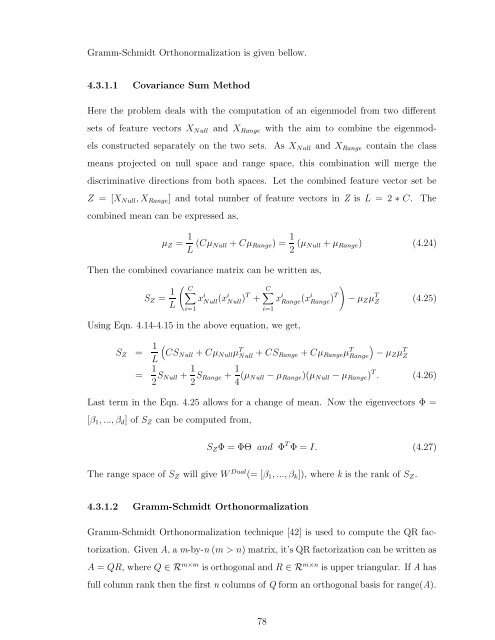Master Thesis - Department of Computer Science
Master Thesis - Department of Computer Science
Master Thesis - Department of Computer Science
You also want an ePaper? Increase the reach of your titles
YUMPU automatically turns print PDFs into web optimized ePapers that Google loves.
Gramm-Schmidt Orthonormalization is given bellow.<br />
4.3.1.1 Covariance Sum Method<br />
Here the problem deals with the computation <strong>of</strong> an eigenmodel from two different<br />
sets <strong>of</strong> feature vectors XNull and XRange with the aim to combine the eigenmod-<br />
els constructed separately on the two sets. As XNull and XRange contain the class<br />
means projected on null space and range space, this combination will merge the<br />
discriminative directions from both spaces. Let the combined feature vector set be<br />
Z = [XNull, XRange] and total number <strong>of</strong> feature vectors in Z is L = 2 ∗ C. The<br />
combined mean can be expressed as,<br />
µZ = 1<br />
L (CµNull + CµRange) = 1<br />
2 (µNull + µRange) (4.24)<br />
Then the combined covariance matrix can be written as,<br />
SZ = 1<br />
�<br />
C�<br />
x<br />
L i=1<br />
i Null (xiNull )T +<br />
Using Eqn. 4.14-4.15 in the above equation, we get,<br />
C�<br />
x<br />
i=1<br />
i Range (xiRange )T<br />
�<br />
− µZµ T Z<br />
(4.25)<br />
SZ = 1 �<br />
CSNull + CµNullµ<br />
L<br />
T Null + CSRange + CµRangeµ T �<br />
Range − µZµ T Z<br />
= 1<br />
2 SNull + 1<br />
2 SRange + 1<br />
4 (µNull − µRange)(µNull − µRange) T . (4.26)<br />
Last term in the Eqn. 4.25 allows for a change <strong>of</strong> mean. Now the eigenvectors Φ =<br />
[β1, ..., βd] <strong>of</strong> SZ can be computed from,<br />
SZΦ = ΦΘ and Φ T Φ = I. (4.27)<br />
The range space <strong>of</strong> SZ will give W Dual (= [β1, ..., βk]), where k is the rank <strong>of</strong> SZ.<br />
4.3.1.2 Gramm-Schmidt Orthonormalization<br />
Gramm-Schmidt Orthonormalization technique [42] is used to compute the QR fac-<br />
torization. Given A, a m-by-n (m > n) matrix, it’s QR factorization can be written as<br />
A = QR, where Q ∈ R m×m is orthogonal and R ∈ R m×n is upper triangular. If A has<br />
full column rank then the first n columns <strong>of</strong> Q form an orthogonal basis for range(A).<br />
78










